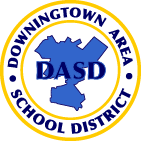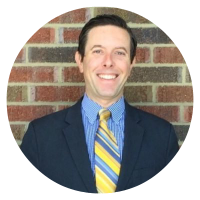An Interview with CAO of Downingtown School District, Matt Friedman
 About Downingtown Area School District
About Downingtown Area School District
- % Free and Reduced Lunch: 10.51%
- # of Staff: 925 Certified Staff
- # of Students: close to 13,000 active students
- Race/Ethnicity: 78.48% White, 3.33% Black, 4.62% Hispanic, and 11.35% Asian
- # of Schools: 3 High Schools, 3 Middle Schools, 10 Elementary
What are your most recent experiences transitioning to student-centered/digital/personalized learning?
I have been extremely fortunate to oversee a 1:1 technology device implementation in my former district and current district over the past several years. While having technology is great, the challenge for me is selecting among the models for personalized learning in my district. There are many ways to make the shift to personalized learning, but the key is to stay focused on the overall learning goals of the school and district and, depending on the goals of the school, or the district, what is required is going to vary greatly.
My recent focus has involved school models in which there is some flexibility around the master schedule, and a culture that emphasizes autonomy of the learners, so that they can own the learning experience and make choices about how to engage in their learning.
People need to remember that student-centered learning is not a quick fix. It is not something you do one Wednesday and suddenly everybody earns better grades the following Tuesday. These changes are systemic, cultural changes that take place over time in an organization.
In addition to the personalized learning opportunities provided for students in Downingtown, I have strived to create similar pathways for our staff as well. Teachers are encouraged to participate in our many robust professional development offerings where they have the chance to develop their own portfolio of personalized professional growth experiences. The hours they accumulate through these professional development opportunities can be exchanged for a flex day in our district calendar thus, providing even more of a chance for personalization.
How would you describe your past five years in education relevant to the use of technology for learning?
The past five years of my career have been transformational, both personally and professionally.
Today, technology is everywhere and heavily entwined in our daily lives, so when it became a daily component of our district classrooms, I was excited to watch it quickly open up endless possibilities for our students and staff. As a central office administrator overseeing our district academics, I am constantly looking for high levels of rigor and student engagement in all of our K-12 district classrooms. With the implementation of 1:1 technologies in all of our buildings we have enriched and enhanced the student’s overall learning process while elevating many of our children’s love for learning.
Most of all, it has been truly amazing for me an administrator to watch the use of technology help transform many staff members in my district into educators who have become conceptual thinkers, generators of robust ideas, and true self-starters.
Through the use of technology in our classrooms, we have developed a robust network of staff members who are freely gathering and sharing ideas with each other and a meaningful platform for students and teachers to research, collaborate, and differentiate their work.
What were your biggest successes in your current/last district?
As I mentioned previously, I have been extremely fortunate to be part of many successful ventures in both my former and current districts. Currently, in Downingtown, those transformations have reached new heights. We have developed an ongoing committment to redefining learning spaces so they provide the best possible environment for both individualized and collaborative learning experiences in all grade levels.
Additionally, we have continued to carefully grow our blended and cyber programming in all content areas. By high school, our students have the opportunity to select the type of instructional delivery that they feel works best for them ranging from a full cyber setting, to a blended or traditional face–to-face learning experience. This year, at the elementary level, we have created a hands-on, STEM focused class for our students called the iDesign Studio. During this time, our students work on and complete design-thinking “challenges,” which help foster the growth of twenty-first century skills necessary in today’s workplace. Next year, we are extremely excited to take the next step in the process and introduce our new Mobile Innovation Lab that will provide STEM focused opportunities for our elementary students beyond the scope of what we can offer in our district classrooms. Students will have hands-on exposure to things like computer programming, robotics and video game design. This mobile lab will travel between our ten elementary schools providing equitable opportunities for all learners across our district.
We are confident these personalized experiences will continue to help prepare all students for life in our ever-changing global economy.
What challenges do you anticipate dealing with in your new/current district?
Greek Philosopher Heraclitus once said, “Change is the only constant in life.”
Joining a very successful school district with consistently high levels of student achievement has been rewarding for me as an educator. However, our success has not come without its fair amount of challenges along the way. Many of these challenges still exist, and our continued success requires me to focus more time on moving many individuals in the district from the comfort of status quo.
One of the biggest challenges we face is overcoming the obstacle of finding the time to provide quality professional development opportunities to our administrative team and the K-12 staff as a whole. With our primary focus being on developing quality instructional practices in our classrooms I am always looking to find time to focus on the necessary skills to create a culture of innovative thinking, collaboration and creativity in our schools. These personalized professional growth opportunities are necessary in order to continue to change our culture. We need to challenge ourselves in determining how the next generation of teachers and administrators will learn the skills necessary for our long-term success.
What are your goals for the first few years in your new/current district? If you had all the resources you need to be successful what would be your goals?
As I approach my second year in Downingtown, I want to continue to develop a deeper understanding of our district’s strengths, challenges, and opportunities through the lens of our district staff and our actively-engaged community stakeholders. To be successful in this process, I need to continue to build trust and confidence through a process of open, honest, and respectful communication while maintaining a continued presence in the school community.
Additionally, as an administrative team we remain committed to providing students the best possible learning environments for success. In a time when an emphasis is on college and career readiness, it is our responsibility to provide students with entrepreneurial and design-thinking opportunities that prepare them to graduate from high school with the necessary career ready skills. Along with student performance and student achievement, I want to make sure Downingtown will continue to make these foundational pillars a priority.
 Lastly, I am always working to ensure the rigor level in our classrooms across the district helps our students best prepare for a rapidly changing world. While technology will continue to have a huge presence in what we do, my goal continues to focus on raising the bar of expectations and possibilities. We will continue to create a culture that encourages our students, teachers and administrators to focus on risk-taking and creative thinking along with challenging the status quo on a daily basis.
Lastly, I am always working to ensure the rigor level in our classrooms across the district helps our students best prepare for a rapidly changing world. While technology will continue to have a huge presence in what we do, my goal continues to focus on raising the bar of expectations and possibilities. We will continue to create a culture that encourages our students, teachers and administrators to focus on risk-taking and creative thinking along with challenging the status quo on a daily basis.
Matt has been an education for 19 years and is currently the Chief Academic Officer in Downingtown Area School District in Pennsylvania. Stay connected by following him and the district on Twitter at @mfriedmanPGH and @DASD_Supt.
